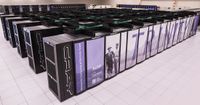-
WikiChip
WikiChip
-
Architectures
Popular x86
-
Intel
- Client
- Server
- Big Cores
- Small Cores
-
AMD
Popular ARM
-
ARM
- Server
- Big
- Little
-
Cavium
-
Samsung
-
-
Chips
Popular Families
-
Ampere
-
Apple
-
Cavium
-
HiSilicon
-
MediaTek
-
NXP
-
Qualcomm
-
Renesas
-
Samsung
-
From WikiChip
Trinity (ATS-1) - Supercomputers
| Edit Values | |
| Trinity | |
 | |
| 2015 | |
| General Info | |
| Sponsors | U.S. Department of Energy |
| Designers | Intel |
| Operators | Los Alamos National Laboratory |
| Introduction | June 2015 |
| Peak FLOPS | 40 petaFLOPS |
| Price | $174,000,000 |
| Succession | |
Trinity (ATS-1) is the successor to Cielo, an 40-petaFLOPS supercomputer by the DoE Los Alamos National Laboratory. Introduced in 2015, Trinity is the first Advanced Technology System (ATS-1) of NNSA's platform strategy. Trinity is expected to be succeeded by Crossroads in 2021.
Facts about "Trinity (ATS-1) - Supercomputers"
| designer | Intel + |
| introductory date | June 2015 + |
| main image |  + + |
| main image caption | 2015 + |
| name | Trinity + |
| operator | Los Alamos National Laboratory + |
| peak flops (double-precision) | 4.0e+16 FLOPS (40,000,000,000,000 KFLOPS, 40,000,000,000 MFLOPS, 40,000,000 GFLOPS, 40,000 TFLOPS, 40 PFLOPS, 0.04 EFLOPS, 4.0e-5 ZFLOPS) + |
| release price | $ 174,000,000.00 (€ 156,600,000.00, £ 140,940,000.00, ¥ 17,979,420,000.00) + |
| sponsor | U.S. Department of Energy (DoE) + |